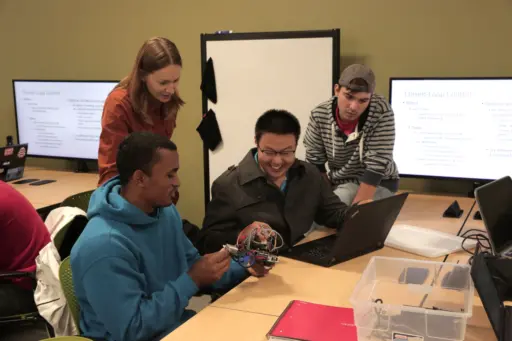The classroom was abuzz with activity as small groups of students huddled around their robots. The robots, which resembled small, motorized chariots, jolted to life and began driving various routes across the floor of the spacious, newly remodeled classroom in the Wendt Building.
 Peter Adamczyk
Peter AdamczykThe goal: to “teach” the robots to follow a specific path as they move.
For many of the teams in Mechanical Engineering Assistant Professor Peter Adamczyk’s Introduction to Robotics course in fall 2017, the first attempt didn’t go as planned. Some robots veered and spun back and forth rapidly. Others whirled until they collided with furniture.
As he circled around the room, Adamczyk fielded questions from students as they worked to troubleshoot issues with their robots. These in-class interactions between the instructor and students spark many fruitful discussions and “a-ha” moments, Adamczyk says.
“Because the students have spent some problem-solving effort on these things before finally raising their hand and asking for help, they realize the importance of these solutions and gain a deeper understanding than if I just told them a problem and then gave them the answer,” Adamczyk says.
This kind of active, hands-on learning is precisely what Adamczyk had in mind when, soon after joining the faculty, he began a significant undertaking in 2016 to completely reinvent the Introduction to Robotics course.
Noting that robotics is fundamentally about “doing,” Adamczyk structured the course to focus largely on practical aspects of robotics and hands-on activities. He teaches the class for seniors and graduate students in a blended learning format: Students watch video lectures, complete and submit homework, and take quizzes, all online; while in class, they work in teams and use modern, low-cost hardware and open-source software to build and interact with robotic systems during almost every class period.
 Students work in teams to “teach” their mobile robots to follow a specific path during the Introduction to Robotics course in fall 2017. Photo: Renee Meiller.
Students work in teams to “teach” their mobile robots to follow a specific path during the Introduction to Robotics course in fall 2017. Photo: Renee Meiller.Adamczyk selected a low-cost development platform so students could afford to keep using these tools after completing the course. “My vision for the course was to focus less on theory and do some things that students can really take and run with on their own,” he says.
By also teaching some practical skills for mechanical assembly and working with electronics, he aims to empower students to become makers. In class, the students assemble their own robots from components including motors, wheels, ultrasonic sensors, free wires and circuit boards. “The course gives students a unique opportunity to build whole systems and physically interact with them, and they really find that valuable,” he says.
The course culminates in a final project. Working in teams, students choose their own advanced robotics projects that build on their prior work. These projects have included: a poster-drawing robot; robots that play tic-tac-toe and Connect Four; robots that navigate while avoiding obstacles; a teach-and-repeat robot arm; and a robot that played a guitar. “For many, the final project is the point where they really come to own their knowledge,” Adamczyk says.
To introduce students to the key concepts and tools underpinning robotic systems, Adamczyk designed the course to focus on two major areas: mobile robots and kinematic control of robot arms. “The field of robotics is broad and changing fast, but almost everything has some mobile aspect and some manipulator aspect, so I wanted to hit on those areas,” he says.
However, Adamczyk says there isn’t a standard textbook or curriculum that covers these areas at a level that’s appropriate for this course. So, with support from an education innovation grant from UW-Madison, Adamczyk created all the course material from scratch.
He says all that work was worth it given the enthusiastic and positive response from students. The second time the course was offered, the enrollment nearly doubled.
“Students have called it their favorite class ever,” Adamczyk says. “Robotics is everywhere these days, and students really want to learn this stuff.”
In February 2018, the College of Engineering recognized Adamczyk for his exceptional work reinventing and teaching the course and awarded him the Harvey Spangler Award for Technology Enhanced Instruction.
Introduction to Robotics course at the University of Wisconsin-Madison